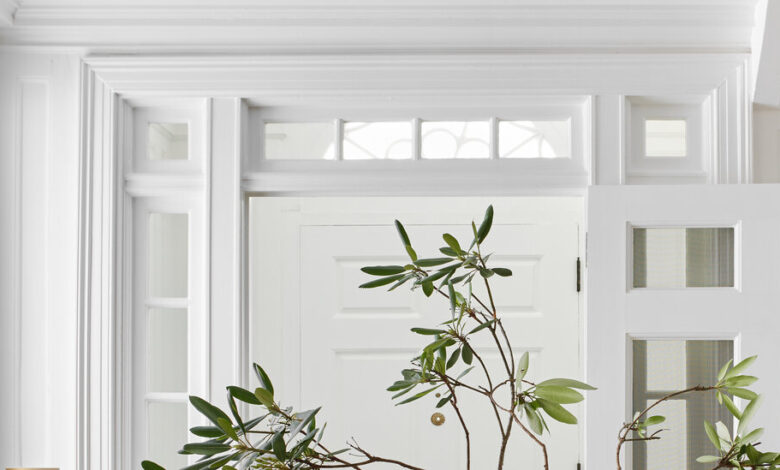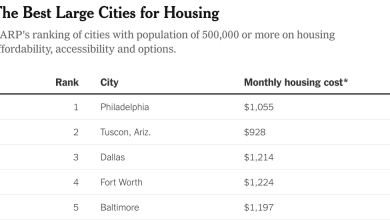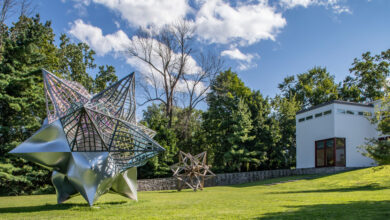How to Give Your Foyer a Spring Makeover

It may not feel like spring yet — but it is.
And as the temperature rises, the stuff you bring into and out of your home changes: Instead of heavy coats and snow boots, you’ll need umbrellas and rain boots, and eventually sunglasses and flip-flops.
That means your entryway — whether it’s a foyer, a mudroom or just the space around your front door — needs to change, too.
“Those rooms take a beating, but they’re also your first impression as you come through the door,” said Whittney Parkinson, an interior designer in Indianapolis. “So they have to be functional, but they also need to be beautiful.”
Achieving that balance takes some doing, Ms. Parkinson said, noting that “there are a lot of small, subtle ways to make them very functional, but also high impact.”
Here’s how she and other designers do it.
Move Your Winter Gear
No matter how big your entryway is, storage space is finite.
So as the weather warms up, move space-hogging ski jackets and boots into deep storage: an attic, a co-op apartment’s storage unit or even just bins stashed under the bed.
When Ms. Parkinson is designing homes for her clients, she likes to install upper cabinets that stretch all the way to the ceiling of a mudroom or entryway for just this purpose. They’re difficult to access without a step stool, but they keep seasonal gear in the room where it’s needed.
“You only need access to those tall upper-storage cabinets when it’s time to switch things out,” she said. “But it’s really nice being able to keep everything in one spot.”
Clear the Clutter
As you relocate your seasonal clothing, don’t mindlessly stuff everything into storage bins — take this as an opportunity to get rid of things you don’t really need.
“Try to get some clarity about what you’re using and what you’re not,” said Regina Lark, the founder of A Clear Path, a professional organizing company in Los Angeles. “We have this fantastical thinking, like, ‘This scarf is going to look so cute when I go out to brunch.’ Well, don’t hang it in your entryway. Keep it in a closet until you’re ready to use it.”
Becoming more of a minimalist can make using your entryway a more pleasant experience: It will be easier to find what you’re looking for, and you’ll avoid the frustration of discovering you don’t have enough space for basic things like hanging up guests’ coats.
To perform an entrance-hall reset, Dr. Lark recommended clearing everything out “and then judiciously placing things in the entryway that you’re really going to use or that you want as a conversation piece when somebody walks in.”
Create a Place for Every Little Thing
You need places to put shoes and jackets, of course. But you should also have a plan for where to put smaller items like keys, wallets, mail, sunglasses and sunscreen.
“You want to be set up for success,” Dr. Lark said. “I do everything I can think of to increase the likelihood that I will be able to access what I need when I need it, and to put things away just as effortlessly.”
One option, she suggested, is to use a series of containers for specific items on a credenza or console.
Nathan Turner, an interior designer in Los Angeles, also recommended using various kinds of containers. “Everything looks better on a tray, in a catchall or in a bucket,” he said. “You’re trying to organize things in a chic way.”
If you would rather keep smaller items out of sight, look for a piece of furniture with drawers.
“I typically like to incorporate a bureau or chest of drawers in my mudrooms for things like key storage, mail, loose paper,” Ms. Parkinson said. “The goal is to make that a drop-off point before entering the house, so that clutter doesn’t carry into the kitchen or other areas.”
Another good idea: an umbrella stand, so you have a dedicated place for umbrellas to drip dry without soaking the floor.
Lighten Up
For many people, dragging out boot trays and rolling out heavy protective floor coverings signals the beginning of winter. Once you’re relatively certain the last snowstorm has passed, be sure to remove them.
In the spring and summer, “you don’t need those heavy rugs to suck up snow melt,” Mr. Turner said. “So pull up those rugs and lighten things up.”
Consider summery replacements: Instead of a dark, synthetic rug with a waterproof backing, roll out a flat-weave cotton rug or one woven from natural grasses; instead of plastic boot trays, consider placing shoes on sisal mats or wood racks.
Make Storage Easy
You can tidy up your entryway at the beginning of spring, but if you don’t make it easy to store things as you come and go, it will be messy again in no time.
That’s why many designers like to add built-in wardrobes and benches with storage drawers when they’re designing entryways from scratch. But even if you’re not renovating, you can still increase a room’s storage space.
One easy way is by adding hooks or peg rails to a wall. “You need hooks,” said Tova Kook, the founder of TK Design, an interiors firm in Woodmere, N.Y. “Because they let you just grab and go.”
If you don’t have a proper foyer or mudroom, a peg rail can help create one.
Mr. Turner installed pegs just inside a door leading to the dining room of a beach house in Malibu, Calif., that he shared with Eric Hughes, another designer. “We didn’t have an entryway, so that’s a good example of how you can make one,” he said, adding that they also placed large galvanized metal buckets on the floor to hold shoes and flip-flops.
Lauren Liess, an interior designer in Great Falls, Va., whose book “Beach Life” will be published in May, said it’s almost impossible to have too many baskets in an entryway. She puts them in cubbies and closed cabinets to hold accessories year round. In the spring and summer, she adds even more, setting them directly on the floor.
“You’ll see piles of baskets,” she said. “I definitely load up on those in the warmer months.”
What does she put in them? Shoes, of course, but also toys, laundry, flowers and vegetables she has picked in the garden — almost anything.
Ms. Liess is also a fan of trunks with upholstered tops. A piece like that can serve as a bench in an entryway, while providing concealed storage inside.
Style for the Season
To make your entryway more than just a glorified walk-in closet, don’t forget to include art and accessories. This is sort of like styling a coffee table: The objects you display should change over time.
“You can go by the season,” said Brittany Hakimfar, the founder of Far Studio, an interiors firm in Philadelphia. “Put branches or florals in a vase that match the season.”
It doesn’t have to be difficult or expensive. “A lot of times when we do a photo shoot, we just go outside and literally cut the branches from the yard,” she said. “That can really add to the space.”
When selecting a few books to display, she considers personal interests she wants to share with guests, but also pays attention to the color of the covers. “If the colors can play into the branches I’m using, that’s something I love,” she said.
She may also put out a new piece of pottery — a sculptural accent that serves as a place to stash keys — as well as candlesticks that can be swapped out depending on her mood.
When it’s done right, “the entryway is one of my favorite spaces to design,” Ms. Hakimfar said, “because it really helps welcome people into your home.
For weekly email updates on residential real estate news, sign up here.
Source link






